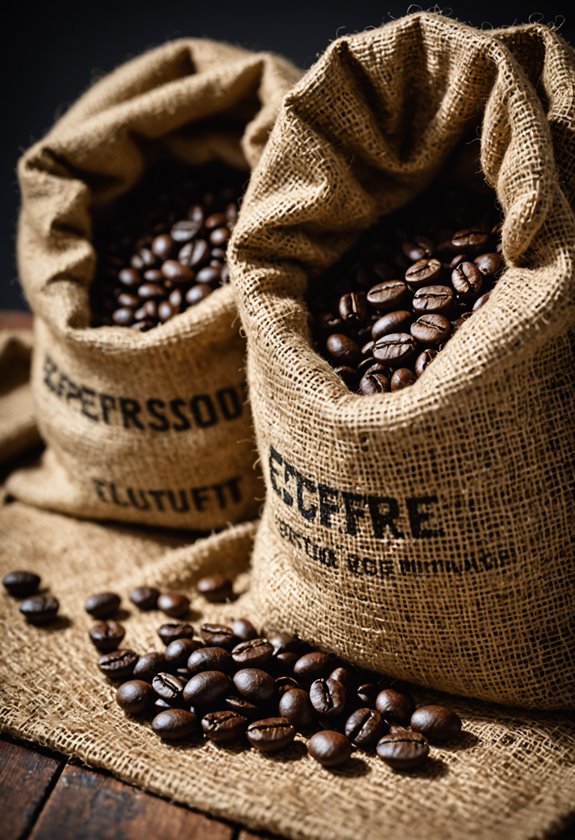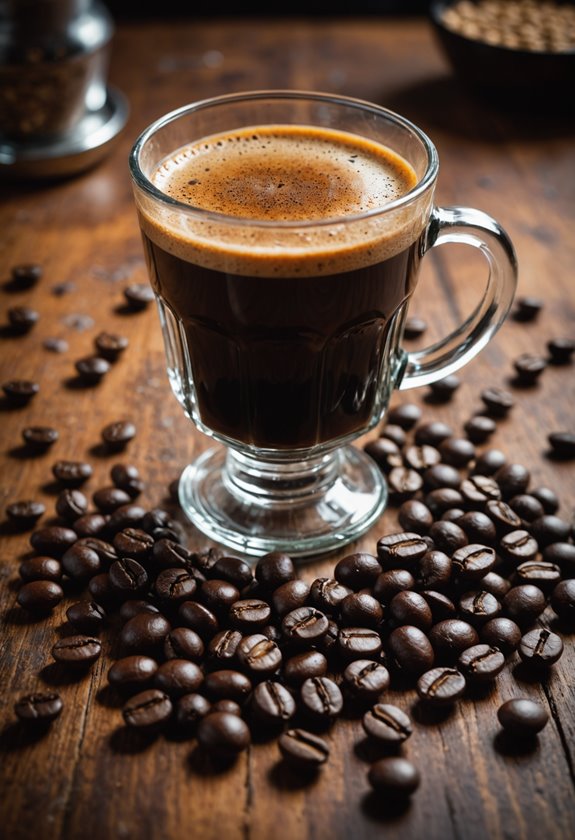What Is the Difference Between Espresso and Coffee Beans?
Let's examine the differences between espresso and coffee beans, starting with their origins. Both come from the same Coffea plant, but espresso beans are roasted longer and at higher temperatures, resulting in a darker roast with bolder, more concentrated flavors. This enhances the natural oils that help form espresso's characteristic crema. Regarding grinding, espresso demands a fine grind for ideal flavor extraction, while regular coffee uses a coarser grind suitable for drip brewing or a French press. Espresso beans are best for high-pressure brewing methods, making them distinct from their versatile coffee bean counterparts. Curious about more complexities?
Key Takeaways
- Espresso beans are dark roasted for concentrated flavor, while coffee beans can be light, medium, or dark roasted.
- Espresso beans undergo longer, high-temperature roasting, enhancing boldness and reducing acidity.
- Espresso requires a fine grind for flavor extraction, whereas coffee uses a coarser grind.
- Espresso features bold, rich flavors from high-pressure brewing; coffee flavors vary from fruity to balanced.
- Espresso beans are suitable for high-pressure espresso machines; coffee beans are versatile for drip and French press methods.
Understanding Coffee and Espresso Beans

When it comes to understanding coffee and espresso beans, it's important to recognize that while both come from the same plant, they serve different purposes in the world of coffee.
Let's investigate these differences. Espresso beans are typically dark roasted, chosen for their ability to produce a rich, concentrated flavor when brewed under high pressure. This dark roast enhances the bold taste and reduces acidity, making espresso distinctively intense.
In contrast, coffee beans vary in roast levels, from light to dark, and each roast affects the flavor differently. Light roasts preserve more of the coffee cherry's original flavors, offering a milder taste.
The role of natural oils is vital, especially in espresso beans. These oils are more prominent due to the dark roast, contributing to the crema—the velvety layer atop an espresso shot.
Grind size also matters; espresso requires a fine grind to guarantee the right flavor extraction during its quick brewing process. Meanwhile, regular coffee can be ground coarser, allowing for a different brewing method and taste.
Understanding these differences in preparation methods allows you to appreciate the unique flavor profiles each type of bean offers, enhancing your overall coffee experience.
For optimal espresso results, using a grinder with precise grind settings like those found in conical burr grinders ensures consistent extraction and flavor quality.
Preparation and Grinding Techniques
Although espresso and coffee beans come from the same plant, their preparation and grinding techniques set them apart.
Let's investigate how these differences impact your brew. When comparing espresso beans vs coffee beans, you'll notice that espresso beans undergo a longer, higher-temperature roast. This dark roast level draws out more natural oils, fundamental for the signature espresso experience.
These oils play a significant role in flavor extraction and contribute to the formation of crema—a creamy, frothy layer unique to espresso.
The grinding technique is another key difference. Espresso requires a fine grind to guarantee maximum oil content is extracted and proper brewing under high pressure.
This fine grind differs from the coarser grind used for regular coffee beans, which suits other brewing methods like drip or French press. Consistency in grind size is essential; an uneven grind can lead to over-extraction or under-extraction, affecting the taste.
Espresso's preparation methods demand specialized equipment that works best with finely ground coffee.
These careful techniques highlight the distinct brewing methods of espresso and ordinary coffee. Understanding these differences enhances your coffee experience and appreciation of each method's unique qualities.
For optimal French press brewing, conical burr grinders provide the most consistent coarse grounds needed for full flavor extraction.
Flavor Profiles and Usage Differences

Because espresso and regular coffee beans are roasted and ground differently, their flavor profiles and uses vary considerably. Espresso beans undergo a dark roast, resulting in bold, rich flavors with a concentrated profile. This kind of roasting brings out the natural oils, giving espresso beans an oily sheen that contributes to espresso's famous crema.
In contrast, coffee beans can be roasted to varying degrees—light, medium, or dark—creating a wide range of flavor profiles, from fruity and nutty to balanced and mild, depending on their origin and roast level.
When brewing coffee, espresso beans are finely ground to maximize oil extraction under high pressure, essential for creating the concentrated flavor of espresso shots. Meanwhile, regular coffee beans, often medium roast, are usually coarsely ground for methods like drip brewing or using a French press, which produce a more balanced, sometimes milder flavor.
Let's examine the differences between espresso beans and coffee beans regarding their usage. Espresso beans are specifically designed for espresso preparation, thriving under high-pressure brewing.
Regular coffee beans, however, offer versatility across various brewing methods, although they mightn't withstand the intense pressure needed for authentic espresso shots. For optimal results in Miele coffee machines, premium Arabica beans are recommended due to their consistent quality and rich flavor characteristics.







